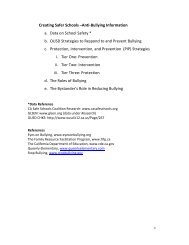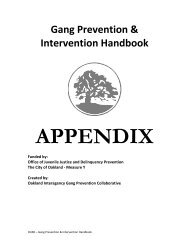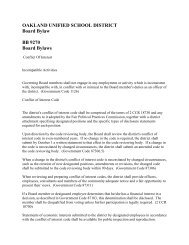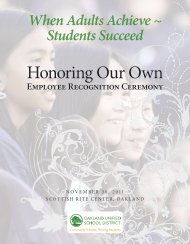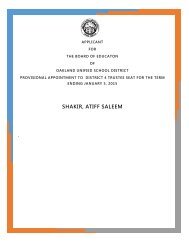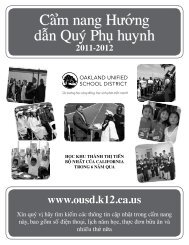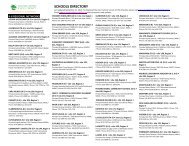Oakland Unified School District Case Study
Oakland Unified School District Case Study
Oakland Unified School District Case Study
You also want an ePaper? Increase the reach of your titles
YUMPU automatically turns print PDFs into web optimized ePapers that Google loves.
use) to garner additional property for the<br />
school.<br />
Securing the resources to build a school was<br />
an important achievement for community<br />
residents. As a school administrator commented,<br />
“This community has been historically<br />
underserved compared to the Fruitvale<br />
community. There are no open spaces or<br />
community centers here. It’s liquor stores<br />
and churches.” Generating the commitment<br />
and resources to build a new school in this<br />
part of East <strong>Oakland</strong> was a critical lever for<br />
developing the community’s resources.<br />
In addition to playing a key role in securing<br />
capital for the school, ACORN also<br />
played an instrumental role in the design of<br />
the school. ACORN members worked with<br />
staff members from the Bay Area Coalition<br />
for Equitable <strong>School</strong>s (BayCES) and met<br />
with teachers and administrators to decide<br />
school governance, curriculum, and community<br />
connections. Despite this advance<br />
work, the project was stalled until Dennis<br />
Chacones was hired as superintendent in<br />
2000. Upon his hire, he agreed to work<br />
with the group to push the school forward.<br />
The group targeted September 2000 for the<br />
opening of the new school. The date was<br />
met with some resistance by the district,<br />
but amidst pressure from the community,<br />
Chacones visited the school site in the summer<br />
of 2000 and, according to one parent,<br />
“took off his suit, got in his jeans and tennis<br />
shoes, began working and opened the<br />
school in portables in September 2000.”<br />
Despite all the energy put into the founding<br />
of AWE, the first few years of operation<br />
were fraught with problems. The<br />
school was designated by Chacones as<br />
one of several schools piloting the Open<br />
Court elementary reading and literacy<br />
curriculum, but many teachers and community<br />
members were more interested in<br />
a focus on social justice. In practice, the<br />
competing visions resulted in the school<br />
effectively implementing neither the Open<br />
Court Reading (OCR) program nor a social<br />
justice program. According to one district<br />
leader, the school had difficulty implementing<br />
the Open Court curriculum because the<br />
school was given the curriculum and materials<br />
at the start of the school year without<br />
any professional development for teachers<br />
regarding its use. The school struggled<br />
implementing the social justice program<br />
because, according to one founding teacher,<br />
there was never a clear vision of what social<br />
justice looked like in practice in the classroom.<br />
Then teacher and now principal,<br />
Kimi Kean, reflected on the problems faced<br />
during the school’s first year:<br />
[There was] lots of turmoil and no<br />
coherent vision. Everyone wanted<br />
to lead the school in a different way.<br />
There were lots of conflicts and<br />
many people left at the beginning.<br />
We started K-5, and the fifth graders<br />
were kids that were underserved for<br />
6 years. The kids were off the hook.<br />
In addition to being under-prepared to<br />
implement the Open Court curriculum or<br />
a social justice program, much of the incoherence<br />
was attributed the disagreements<br />
among staff and school leadership. The<br />
founding principal — who was selected<br />
by the superintendent and was new to the<br />
principalship as well as to the community<br />
— clashed with faculty over the direction of<br />
the school, and at the conclusion of AWE’s<br />
first year, it emerged as the lowest performing<br />
elementary school in the city. 10 According<br />
to one school official, “All the energy<br />
around change did not produce increases<br />
in achievement.” Insufficient professional<br />
development for teachers, combined with<br />
OUSD <strong>Case</strong> <strong>Study</strong>: ACORN Woodland Elementary 5



